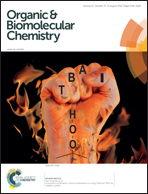New multi-target-directed small molecules against Alzheimer's disease: a combination of resveratrol and clioquinol†
Abstract
Alzheimer's disease (AD) is currently one of the most difficult and challenging diseases to treat. Based on the ‘multi-target-directed ligands’ (MTDLs) strategy, we designed and synthesised a series of new compounds against AD by combining the pharmacophores of resveratrol and clioquinol. The results of biological activity tests showed that the hybrids exhibited excellent MTDL properties: a significant ability to inhibit self-induced β-amyloid (Aβ) aggregation and copper(II)-induced Aβ aggregation, potential antioxidant behaviour (ORAC-FL value of 0.9–3.2 Trolox equivalents) and biometal chelation. Among these compounds, (E)-5-(4-hydroxystyryl)quinoline-8-ol (10c) showed the most potent ability to inhibit self-induced Aβ aggregation (IC50 = 8.50 μM) and copper(II)-induced Aβ aggregation and to disassemble the well-structured Aβ fibrils generated by self- and copper(II)-induced Aβ aggregation. Note that 10c could also control Cu(I/II)-triggered hydroxyl radical (OH˙) production by halting copper redox cycling via metal complexation, as confirmed by a Cu–ascorbate redox system assay. Importantly, 10c did not show acute toxicity in mice at doses of up to 2000 mg kg−1 and was able to cross the blood–brain barrier (BBB), according to a parallel artificial membrane permeation assay. These results indicate that compound 10c is a promising multifunctional compound for the development of novel drugs for AD.


 Please wait while we load your content...
Please wait while we load your content...